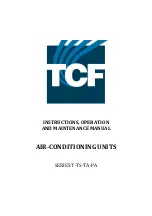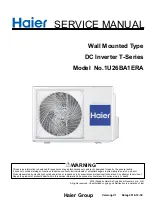
8
Indoor Unit Condensate Piping Connections
IMPORTANT
Make sure that drain piping is properly routed and
insulated to prevent both leaks and condensation.
1.
Use a field-provided hose clamp to secure the drain
line stub on the side of the cassette base to a field-
supplied 1” (25 mm) drain line.
NOTE:
Take care not to over-tighten the hose clamp as
this may damage the drain line stub.
NOTE:
Connection between stub and drain line must be
watertight. Apply non hardening plumbing joint
compound if needed to ensure a watertight seal.
2.
Confirm proper slope (not less than 1/4 inch per foot
(18 mm per m)) and routing of condensate lines to
ensure moisture is drained away from the indoor unit.
3. Drain should be as short as possible and should
not have any droops or kinks that would restrict
condensate flow and shall be approved resistant pipe.
There must be a 2-inch (51 mm) space between
the end of the condensate drain and the final
termination point (ground, open drain, etc.) to
ensure that the line will drain freely.
4. After the system installation is complete, the
condensate drain line must be checked for leaks and
proper drainage. If a field-provided condensate pump
has been installed, it must be checked to ensure proper
operation. This check is part of the start-up process
which must be done by the installing contractor.
IMPORTANT
Drain should have a slope of at least ¼ inch per foot and
should be approved corrosion-resistant pipe. You must
confirm operation of every drain and pump in the system
as part of the commissioning procedure.
Outdoor Unit Installation
Placement Considerations
CAUTION
In order to avoid injury, take proper precaution when
lifting heavy objects.
Consider the following when positioning the unit:
• In coastal areas or other places with salty atmosphere
of sulfate gas, corrosion may shorten the life of the
unit. In coastal areas, the coil should be cleaned with
potable water several times per year to avoid corrosive
buildup (salt).
• Some localities are adopting sound ordinances based
on the unit’s sound level registered from the adjacent
property, not from the property where the unit is in-
stalled. Install the unit as far as possible from the prop-
erty line.
• When possible, do not install the unit directly outside
a window. Glass has a very high level of sound trans-
mission.
• Install unit level.
Ground
Level
Building Structure
Figure 6.
Install Unit Level
• Choose a place solid enough to bear the weight and
vibration of the unit, where the operation noise will not
be amplified.
• Choose a location where the hot air discharged from
the unit or the operation noise will not be a nuisance
to neighbors.
• Avoid installing the outdoor unit near a bedroom or
other places where noise may cause a problem
•
There must be sufficient space to carry the unit into
and out of the site.
•
There must be unobstructed air flow around the air in
-
let and the air outlet.
•
The unit must not be installed in areas where a flam
-
mable gas leak may occur.
• Install the outdoor unit a minimum of 3 feet (1m) away
from any antenna, power cord (line), radio, telephone,
security system, or intercom. Electrical interference
and radio frequencies from any of these sources may
affect operation.
• Since water drains from the outdoor unit during vari-
ous stages of operation, do not place anything which
may be damaged by moisture under the unit.
Direct Sunlight, Rain, Snow and Ice Protection
• If the outdoor unit is subjected to prolong exposure to
direct sunlight with temperatures over 100°F (38°C) a
canopy is suggested as illustrated in “Figure 7. Out
-
door Unit on Pedestal (Stand) and Protective Canopy”
or “Figure 12. Dog House-Style Shelter” on page 10.
IMPORTANT
The construction of a canopy or shade is necessary
because of an ambient limit control set to 122°F (50°C)
to protect the electronics. If the outdoor unit is placed in
direct sunlight it is possible that the limit may activate
and shut down the unit.
• Place unit away from overhanging roof lines which
would allow water or ice to drop on, or in front of, coil






































